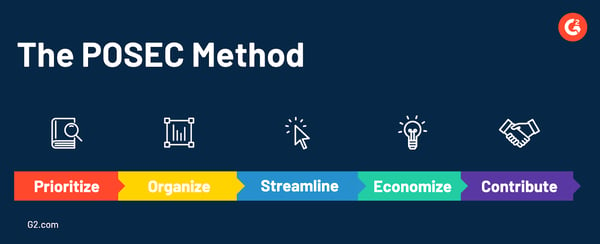November 7, 2025
 by Lauren Pope / November 7, 2025
by Lauren Pope / November 7, 2025

Oh no, I am late for the meeting. Again.
These words may resound in your ears as they come out of your mouth quite often. Being late has become a habit in our daily lives, to the point where we barely even notice it, while continuously making excuses. Why does it happen? Due to a lack of poor time management.
A clear timeline roadmap of your upcoming tasks and projects, combined with time tracking software, can help you mitigate workload without compromising productivity.
The five P's of time management are Prioritize, Plan, Prepare, Pace, and Persist. These principles guide effective time use by identifying key tasks, organizing steps, getting ready in advance, maintaining consistent effort, and staying committed to goals.
People often confuse time management with meticulous, minute-by-minute planning. That’s not what this article is about. Instead of becoming hyper-focused on optimizing every moment of your life, the goal is to find a schedule that works best for you.
Most people don’t realize they have a time management problem until they’re already overwhelmed, and by then, the effects are compounding. Poor time habits fuel stress, increase mental fatigue, and quietly drain your productivity.
When you're constantly reacting instead of planning, it becomes harder to focus, easier to miss deadlines, and nearly impossible to create boundaries between work and personal life.
Left unchecked, poor time management blurs the lines between effort and effectiveness. You may find yourself working long hours yet making minimal progress, always busy but never ahead. It also quietly erodes opportunities. The time spent on unimportant tasks is time not spent on building new skills, deepening relationships, or advancing your career.
That’s why time management is more than just a nice-to-have productivity trick. It’s a foundational skill that directly impacts your well-being, your goals, and how you show up in every part of your life.
Tip: Use the best reference management software to improve your productivity. Organize citations, track sources, and eliminate the hassle of manual referencing.
The practice of a time management technique encourages positivity and productivity in your work schedule. By following these techniques, your workload should be manageable, and you should be able to spare time for personal interests as well.
Many professionals nowadays follow online time management techniques, listed as follows.
Time management isn’t just for CEOs or hyper-productive entrepreneurs. It’s a universal skill that benefits anyone with tasks, goals, or responsibilities (all of us). Whether you’re a full-time student, a stay-at-home parent, a freelancer, or a project manager juggling back-to-back meetings, how you manage your time determines how effective and how sane your day feels.
For professionals, strong time management means hitting deadlines without burnout, carving out space for deep work, and staying aligned with team goals. For parents, it can mean coordinating multiple schedules while still making time for themselves. For students, it’s the difference between all-nighters and balanced semesters.
Even high achievers with packed calendars rely on effective time management to conserve their energy. No matter how ambitious or laid-back your goals are, knowing how to use your time wisely gives you more freedom. It helps you say no to distractions, yes to priorities, and stay present, wherever you are.
Not sure if time management is really your issue? The tricky part is, time-related problems often show up disguised as something else, like procrastination, poor focus, or feeling constantly overwhelmed.
The first step to better time management is realizing that focus, energy, and attention are just as important to track as hours on the clock.
You don’t have to be floundering to adopt better time management strategies. The work of time management is never truly done. There’s always something you can plan better or work on improving.
Time management is such a widely recognized concept that it has given rise to numerous specific methodologies over the years. While some have come and gone, there are three popular ones that many consider the ”Holy Trinity” of time management.
The Eisenhower Decision Matrix, more commonly known as the 4 Ds of time management, can be broken down into four simple components: do, defer, delegate, and delete. This method revolves around the idea that everything you spend your time doing falls into two main categories: urgent/not urgent and important/unimportant.
Under the Eisenhower method, tasks that are considered important and urgent should be at the top of your to-do list, while tasks that are neither urgent nor important can probably be done away with altogether.

That table might seem a bit confusing, but in reality, it’s simple.
Once you understand how to categorize your tasks using the Eisenhower Matrix, you can decide how to schedule your day. The most important and urgent tasks can be completed first, while the least urgent and important can be left for later if time allows.
The Pareto principle, also known as the 80/20 rule, was crafted with the idea that 80% of your results come from 20% of your efforts. This method focuses on the 20% of efforts that impact the largest portion of your outcomes. It’s about taking a comprehensive assessment of your workflows and maximizing efficiencies by leveraging your best assets.

Let’s say you have a website and want to optimize your content to boost organic website visits. The Pareto principle suggests you find the articles driving the most visits to your website and focus on those rather than optimizing everything.
By focusing on your top-performing articles (20%) that drive the most traffic (80%), you can drive more actionable results with less effort. Does that mean those other articles on your website are worthless? No. It just means they aren’t a priority for this specific project.
The POSEC method is a five-step process designed to help you manage your time better. This method was modeled after Maslow’s Hierarchy of Needs. Basically, you complete tasks in the order that are more important to finish and put the least important tasks at the end.
POSEC stands for Prioritizing by Organizing, Streamlining, Economizing, and Contributing.

Prioritizing simply means you put the most important things first. That could be as simple as creating a list and ranking your tasks from most to least important, then completing them in that order.
Organizing means you lay out a strategy for how you’re going to complete these tasks. This helps your goals feel more attainable, and it makes tasks easier to complete. When you have a strategy for how things get done, they get done faster.
Streamlining focuses on the tasks that you don’t want to do, but need to get done. Cleaning your dishes, folding your laundry, and so on. These are the mundane tasks that can’t be ignored. Streamlining is designed to get them done more quickly and effectively, so you can focus on the important tasks at hand.
Economizing refers to tasks that you enjoy doing. These are your hobbies and your leisure activities. While these might be the most fun to do, they’re not needed. You should place these tasks at the bottom of your to-do list.
Contributing includes your social obligations. This can include attending a friend’s party or volunteering at an animal shelter. These tasks include other people relying on you, so they tend to be placed higher on the list than solo projects.
Start with the one that best fits your current struggle:
Ultimately, you’ll probably need to try more than one of these methods before finding one that works for you. Don’t be afraid to mix and match strategies from all of them and create your own!
People who excel at time management all share one common trait. It’s not that they’re smarter or naturally gifted; it’s that they’ve created a system that works for them.
There’s no uniform time management strategy that works for everyone. But with the right skills, you can find a way to manage time that works best for you.
Staying organized is one of the most important skills to have when managing time effectively. This involves organizing your schedule, priorities, obligations, and more. Find a way to organize all of your most important information in one place.
Once you’ve organized everything, it’s time to prioritize your tasks. The most important things should be at the top of your to-do list. Try creating a short list of three “must-dos” every morning before you leave your house. No matter how hectic things get, you can refer to those most vital tasks as your guide for what needs to be done.
You’re likely going to run into tasks that need to get done but aren’t a priority — this is where delegation comes in. Whether at work or home, you can delegate these less important tasks to other people. If nobody else is available to do them, you can always defer these tasks for later.
Forgetting to schedule downtime for yourself is a huge mistake. Time management encompasses every part of your life, including your Monday night Bachelor watching session! Don’t feel guilty about allowing yourself time to decompress and just chill every once in a while.
You’re not the only person who needs to be aware of your time management. Your partner, children, coworkers, and friends need to be aware of your strategy. Communicate your boundaries with people and stick to them. Don’t let others pressure you into breaking a good habit.
Setting goals for yourself helps you stay accountable. Try starting small by scheduling a few key tasks to accomplish each week. Once you’ve got the hang of that, you can focus on longer-term goals for yourself. Perhaps you'd like to spend more time reading? Or get more done at work? These are all goals that time management can help you achieve.
The obvious benefit of time management is that you’ll have more time in your day to get things done. But there are other, more subtle advantages to managing your time better. These perks can help you immensely in both your personal and professional life.
This one is a no-brainer. When you spend less time focusing on how you’re going to get everything done, your stress levels decrease significantly. Planning and executing your schedule without procrastination gives you more time to do the things you love doing, instead of worrying about how you’re going to do all the things you need to do.
Creating a schedule and executing tasks on a timeline will improve the quality of your work. Knowing what you’re getting done allows you to be fully present in the moment. You don’t have to worry about pre-planning and can focus on completing your work instead.
When you use your time more effectively, you actually gain more time. Those wasted minutes you used to spend checking your phone or avoiding work add up. This means you can take on more projects, new hobbies, or even have time to just relax. The world opens up once you take control of your time.
One of the biggest side effects of poor time management is an unbalanced work and home life. If you find yourself taking work home with you every night, there’s a chance you have a problem with wasting time at work.
Better time management at work will free up your personal life. When you stop taking work home with you, it can give you more time for your hobbies, your spouse, your children, or your pets. It’s a win-win for every aspect of your life!
Making the most of your time is tricky. There will always be things in your life that you absolutely have to do. Picking your kids up from school, making dinner, and showering are things that take up time that you can’t just stop doing. Making the most of your time is an invaluable skill that can benefit every aspect of your life.
Time blocking is a popular project management strategy where you block off large sections of your calendar every day for a specific activity. Time blocking encourages you to focus on what needs to get done and sets an expectation for when these tasks will be completed. It can be done in your online calendar or even a personal planner.
Here’s an example of what a time-blocked schedule looks like compared to an open calendar:

Notice how there are scheduled breaks in between these large blocks of time? This allows you space to attend to other things as they arise throughout the day. What makes time blocking great is that it also communicates to other people when you are busy, which lessens the chance for distractions during the day.
You might be surprised to learn that multitasking is actually making your time management worse. As a matter of fact, tasks take up to 15% longer when trying to multitask.
Only a few people can multitask effectively, and you probably aren't one of those super-taskers. It's better to focus on one task at a time and complete it before moving on.
Procrastination is one of the most challenging aspects of time management. It’s very easy to fall into the mindset of “doing things later”. We all know what can happen when you push everything off to do later. You’ll need to face your procrastination head-on if you want to get better at managing your time.
Don’t let yourself get into a shame spiral over procrastination. We all do it from time to time. Focus on what you’re doing to overcome the urge to push things off. Create a plan and stick to it. You might be surprised how easy it is to beat procrastination with a little mindfulness!
For many of us, technology falls into the category of distractions. But in some cases, it can actually help you manage your time better.
If you’re looking to manage your personal life better, there are tons of time management apps that you can download directly to your phone. These apps range from calendar apps to scheduling tools and more!
For professionals looking to manage their time better, there are more than 750 project management software options available on the market. These tools allow you to create workflows, tag teammates in new projects, and track your time more effectively.
Find the best project management software on the market based on real user reviews from people like you.
It’s impossible to manage your time better if you don’t know what you’re using your time for. Spend a full week tracking your day-to-day in a planner or calendar. Write down what you’re doing throughout the day, whether it’s eating, napping, or working. Once you have the full picture of how you spend your time, it’s easier to decide what can stay and what can go.
Learning how to say no will save you a lot of trouble. As we mentioned earlier in the Eisenhower Decision Matrix, not everything is worth your time! Be more discerning about the projects you commit your time to and which ones you let fall by the wayside. Learning to value your time will make managing your schedule much easier.
Perfectionism can be a double-edged sword. Time is often wasted on trying to get the details of a project exactly right, losing valuable time you could use doing something else. You can counteract this by setting a predetermined amount of time to complete a task. If you know you only have an hour to get something done, you’re less likely to waste time on other things.
You know how some people meal prep their entire week of meals on Sunday? You can do the same thing with your time.
Sit down and time block each day of your week every Sunday evening. This sets a schedule you can stick to and frees up time in your schedule. Then, you can spend the first 15 minutes of each day reviewing your time blocks and adjusting for anything that came up since you scheduled things. Planning ahead and adjusting daily will add up to hours saved over time.
Nothing beats a good old-fashioned planner. It’s your lifeline for what’s happening when. Some people prefer to use a physical planner while others go the digital route. No matter which option you choose, a planner will keep you accountable for sticking to the schedule you create for yourself.
One of the biggest reasons people procrastinate is that they dread doing a difficult or time-consuming task. You can break this habit by getting those demanding tasks out of the way first.
Once you’re over the hill of your most difficult projects, everything else will seem like a breeze! Plus, it gives you a sense of accomplishment that can boost your energy for the rest of the day.
You don’t have to spend every second of every day on a schedule. It’s important to pencil in time to relax with your family or watch your favorite Netflix show. Try giving yourself one day a week where you don’t schedule anything to do. Let the day take you where it will and just go with the flow. This helps you recharge your batteries and prevent burnout.
There’s a good chance that you’ll encounter someone who tries to derail your time management habits. Whether that’s a coworker or family member, you need to establish firm boundaries with them. This could mean saying no to ineffective or bad meetings, or reminding your spouse that you need time to complete certain tasks. Staying firm in your plan is crucial to your success.
G2 assists businesses in discovering time tracking solutions that enable workers to allocate their work hours, enhance productivity, and manage their pipelines with a relaxed approach.
*Below are the top five leading time tracking software from G2’s Fall 2025 Grid® Report. Some reviews may be edited for clarity.
UKG Ready is a unified HCM solution that combines payroll, talent, scheduling, and time tracking into a single cloud-based platform. Built for mid-sized businesses, it streamlines core HR functions including leave management, compliance, onboarding, and performance.
"As an HR Analyst in the SaaS industry, I use UKG Ready daily to manage employee records and generate reports. The platform’s user-friendly interface makes it easy to navigate even complex data sets. The reporting capabilities are particularly impressive, being detailed, customizable, and easy to export for analysis. UKG Ready also offers a wide range of features that support our HR operations, and the system is flexible enough to adapt to our workflows. Tasks like updating employee data, tracking time-off requests, and pulling analytics are streamlined and efficient. Overall, it’s a reliable and scalable solution that supports data-driven decision-making."
- UKG Ready review, Simon D.
"The only downside was remembering to clock in and out in the beginning. As a supervisor, I had numerous employees who would forget to clock in or out, and having to do change requests for them was a pain. Eventually, with time, it got easier."
- UKG Ready review, Melinda D.
monday Work Management is a work automation platform that synchronizes projects, organizes schedules, and sets async project updates through a series of dashboards, automation, and agile tools. Employees can automate and build their own time management capsules and automate task updates and alerts to plan their work weeks in an efficient way.
"monday.com is used throughout the various departments to help track information. It is a great tool for keeping track of items, recording their progress, and conveying statuses. It helps our team members stay in touch with each other on a specific project. monday.com is great for us because we have several remote working teams. We really like how each member can log in and work on a project at the same time."
- monday Work Management review, Shubham J.
'It is quite pricey in Asia. Apps sometimes get slow or even go down without notice. And some automation doesn't always execute correctly. But overall, it's amazing!"
- monday Work Management review, Wiwin A.
ClickUp is a popular team productivity and collaboration platform that helps you set schedules for your daily agendas, stand-ups, and scrums. ClickUp enables transparency and visibility into company-wide tasks, and updates project members in real-time on the updates and modifications made through your platform. It also comes with an embedded Gantt chart template to help you plan and prioritize your projects more effectively.
"The ease of use is absolutely amazing. ClickUp is extremely easy not only to users but for the entire team. It's also very easy to customize to get the best value out of it. An amazing amount of ClickApps (plug-ins/addons) and integrations with everything from custom fields, relations/dependencies, calendar, email, and other integrations. My top picks will be automations and built-in AI assistance."
- ClickUp Review, Oskar B.
"ClickUp sometimes does not store data that's been entered into fields--example: I can enter a date into a text field, but it won't remain there and will default to whatever was there before. It can be frustrating and lead to a sense of unreliability."
- ClickUp Review, Lea M.
Deel is a global HR and payroll platform designed for remote-first teams. It enables companies to hire, onboard, and pay international employees and contractors in compliance with local laws, all from a single centralized dashboard.
"I appreciate how Deel simplifies my payment processing. With Deel, my company sends my payment directly, and I can then easily settle it through Deel, which transfers the amount directly into my bank account. The process is straightforward and efficient. I love the simplicity of navigating to Deel, accessing my account section, and withdrawing my payment without any hassle. The transfer to my bank account is timely, usually within six to seven hours, which I find very efficient and reliable. This hassle-free process allows me to manage my payments with minimal effort, making it a seamless experience."
- Deel review, Vaibhav U.
"I think the mobile app is somewhat slow; it takes time to load to navigate through the functions."
- Deel review, Joel V.
Connecteam is an all-in-one employee management platform built specifically for deskless and mobile teams. It centralizes scheduling, task management, time tracking, communication, and training into one app.
"Intuitive interface and ease of implementation and integration. Easy to use frequently throughout the day. Lots of communication tools like chat, updates, and task assignments. Mobile app accessibility for field workers. Quick and efficient responsiveness from customer support."
- Connecteam review, Nicole B.
"There is a bit of a learning curve, and I’m still discovering some of its features months later, but those are just small quirks that don’t affect how well it works for us overall."
- Connecteam review, Sara Y.
Got more questions? We have the answers.
The Pomodoro Technique is one of the simplest to try. Work in 25-minute focused sprints followed by short breaks. It requires no tools beyond a timer and helps improve concentration and reduce procrastination.
Common signs include missing deadlines, constantly multitasking, feeling overwhelmed despite being busy, and lacking time for personal priorities. If you regularly feel reactive instead of proactive, it’s worth reassessing how you manage your time.
Yes, time tracking and scheduling tools give you visibility into where your time goes. They help you stay accountable, reduce distractions, and make better decisions about how you spend each day.
Time blocking is scheduling specific time slots for deep work, while task batching groups similar tasks together to reduce context switching. Both can be used together for a more focused workflow.
It depends on your role and schedule, but 2–4 hours of distraction-free work time per day is a strong baseline for most knowledge workers. Use your peak energy windows to get the most from those blocks.
You don’t need to be. Time management is a skill, not a personality trait. Start with small systems, like daily prioritization or blocking 1 hour of focused work, and build consistency over time.
Time blocking and async collaboration tools are especially effective in remote settings. They help structure your day and signal availability to your team without constant check-ins.
Once you’ve mastered the art of time management, your days of yearning for a time machine will be a thing of the past. You’re in charge of your time. It might take some serious adjusting at first, but utilizing these tools will help you reclaim your time before you know it!
Don't let the troublesome work past come back to haunt you. Learn how to diligently manage your tasks with the best free task management software.
Lauren Pope is a former content marketer at G2. You can find her work featured on CNBC, Yahoo! Finance, the G2 Learning Hub, and other sites. In her free time, Lauren enjoys watching true crime shows and singing karaoke. (she/her/hers)
As someone who’s walked the tightrope of being both a freelancer and has managed freelancers...
 by Keerthi Rangan
by Keerthi Rangan
Ever feel like your day disappears before you’ve accomplished anything meaningful? Between...
 by Harshita Tewari
by Harshita Tewari
We can all agree that employees deserve to be compensated for their hard work.
 by Rob Browne
by Rob Browne
As someone who’s walked the tightrope of being both a freelancer and has managed freelancers...
 by Keerthi Rangan
by Keerthi Rangan
Ever feel like your day disappears before you’ve accomplished anything meaningful? Between...
 by Harshita Tewari
by Harshita Tewari
